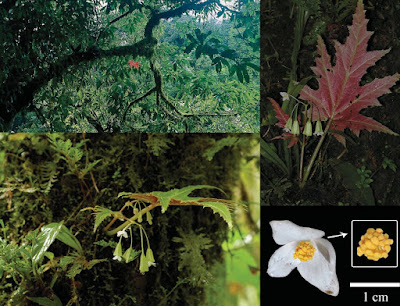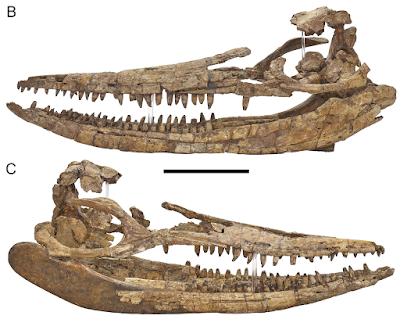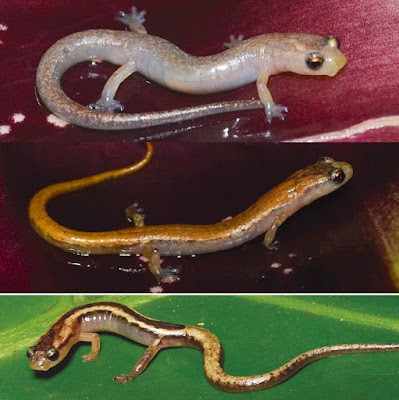[Most Recent Entries] [Calendar View]
Thursday, January 10th, 2019
| Time | Event | ||||
| 7:03a | [Botany • 2018] Begonia garrettii & B. pseudodryadis • Reassessment of Begonia arboreta and B. sonlaensis (Begoniaceae) based on Field Observation and Type Examination
Abstract Due to the unavailability of specimens and publications in the past, some gaps exist in knowledge of similar species from various adjacent countries. After more recently detailed observations from field surveys and examinations on herbaria specimens, we confirmed the status of Begonia arboreta and B. sonlaensis as synonyms of B. garrettii and B. pseudodryadis from China and Thailand, and from China and Vietnam, respectively. The taxonomic treatment is based on the examination of both available herbarium specimens and living plants from different populations. Taxonomy revision of the allied species is very important for understanding plant diversity in the above neighboring countries. Keywords: Begonia, Indochina, Karstic limestone, Plant diversity, Plant taxonomy, Eudicots •• Begonia garrettii Craib, Bull. Misc. Inform. Kew: 411, 1930. Type:—THAILAND. Chiang Mai: east slope ending in Doi Pa Mawn, elev. 1450 m, 22 September 1927, flower white with violet red tinge, on rocks, aneroid, H.B.G. Garrett 462 (holotype: ABD [ABDUH 2/620]!; isotype: ABD [ABDUH: 2/619]!, K [000761183, 000761184, 000761185]!, E [00265176]!, TCD [0017184]! (Figs. 2 & 3). —Begonia arboreta Y.M.Shui, Acta Bot. Yunnan. 24(3): 307, fig. 1, 2002. Type:—CHINA. Yunnan, S.K. Wu, Y.M. Shui, Y.P. Yang, L.H. Liu, J.H. He, J. Murata, H. Nagamasu, T. Sugawara, X. Chen, N. Murakami 144 (holotype: KUN [0773200]!). syn. nov. Distribution and Ecology:— South Yunnan in Southwestern China and Chiang Mai province in the north of Thailand (Fig. 1). It grows exclusively as an epiphyte in montane forests at elevation 1400–1860 m a.s.l. •• Begonia pseudodryadis C.Y.Wu, Acta Phytotaxonom. Sin. 33(3): 251, fig. 22, 1995. Type:—CHINA. Yunnan: Pingbian county, Yaoshan, elev. 1320 m, on mossy rocks in valley, 6 July 1953, P.Y. Mao 2389 (holotype: KUN [0371714]!; isotype: KUN [0371713]!, IBSC [19530706]!) (Figs. 4 & 5). —Begonia sonlaensis Aver., Turczaninowia 15(2): 26, 2012. Type:—VIETNAM. Son La Province: L. Averyanov, CPC 1876aa (holotype: LE!). syn. nov. Distribution and Ecology:— The species is distributed in Southeastern Yunnan, Southwestern China, and Sonla and Dien Bien provinces, northwestern Vietnam (Fig. 1). It grows exclusively as a lithophyte on limestone karstic hills, commonly on cliffs or among rocks at elevation 670–1800 m a.s.l. Wen-Hong Chen, Sirilak Radbouchoom, Hieu Quang Nguyen, Thamarat Phutthai, Leonid V. Averyanov and Yu-Min Shui. 2018. Reassessment of Begonia arboreta and B. sonlaensis (Begoniaceae) based on Field Observation and Type Examination. Phytotaxa. 381(1); 132–140. DOI: 10.11646/phytotaxa.381.1.17 | ||||
| 2:32p | [Paleontology • 2019] Descriptive Anatomy of the Largest Known Specimen of Protoichthyosaurus prostaxalis (Reptilia: Ichthyosauria) including Computed Tomography and Digital Reconstruction of A Three-dimensional Skull
Abstract Ichthyosaur fossils are abundant in Lower Jurassic sediments with nine genera found in the UK. In this paper, we describe the partial skeleton of a large ichthyosaur from the Lower Jurassic (lower Sinemurian) of Warwickshire, England, which was conserved and rearticulated to form the centrepiece of a new permanent gallery at the Thinktank, Birmingham Science Museum in 2015. The unusual three-dimensional preservation of the specimen permitted computed tomography (CT) scanning of individual braincase elements as well as the entire reassembled skull. This represents one of the first times that medical imaging and three-dimensional reconstruction methods have been applied to a large skull of a marine reptile. Data from these scans provide new anatomical information, such as the presence of branching vascular canals within the premaxilla and dentary, and an undescribed dorsal (quadrate) wing of the pterygoid hidden within matrix. Scanning also revealed areas of the skull that had been modelled in wood, clay and other materials after the specimen’s initial discovery, highlighting the utility of applying advanced imaging techniques to historical specimens. Additionally, the CT data served as the basis for a new three-dimensional reconstruction of the skull, in which minor damage was repaired and the preserved bones digitally rearticulated. Thus, for the first time a digital reconstruction of the skull and mandible of a large marine reptile skull is available. Museum records show the specimen was originally identified as an example of Ichthyosaurus communis but we identify this specimen as Protoichthyosaurus prostaxalis. The specimen features a skull nearly twice as long as any previously described specimen of P. prostaxalis, representing an individual with an estimated total body length between 3.2 and 4 m. Conclusions: In this study, we describe a large, partial ichthyosaur skeleton from the Early Jurassic of Warwickshire, England. In addition to examining the specimen, we carried out CT scanning of individual skull bones as well as the entire, reassembled skull, one of the first times the skull of a large marine reptile has been successfully CT-scanned, visualized and reconstructed in 3D (see McGowan, 1989; Foffa et al., 2014a). CT scanning contributed greatly to our anatomical description by revealing features not visible on original fossil material such as: branching, longitudinal vascular canals within the premaxilla and dentary; short canals penetrating the nasal, lacrimal, stapes and articular; trabecular bone within the opisthotic; canals in the basisphenoid and supraoccipital; the presence of the quadrate process of the pterygoid; and the sutural morphology. We also demonstrate the utility of applying medical imaging techniques to historic specimens to differentiate between original fossil material and reconstructed regions, as well as the advantage of using digital visualization to accurately reconstruct large fossil specimens in 3D. The detailed description of the three-dimensional skull and braincase presented herein also provides information that can be used in phylogenetic studies. Although incomplete, the skull and braincase preserve various elements that have not previously been reported or described in any specimen of Protoichthyosaurus and therefore it provides more information about this taxon so that its phylogenetic position can be explored in more detail. Furthermore, our study has found additional characters that may lend further support for the distinction of Protoichthyosaurus from its sister taxon Ichthyosaurus, such as the morphology of the pterygoid and anteroventral surface of the parietal, which differ from that described for Ichthyosaurus (McGowan, 1973). However, considering that only a couple of specimens preserve these elements, it is possible that the differences may be the result of individual variation; more three-dimensional specimens of both taxa are needed to test and clarify these findings. Based on a unique combination of characters, we identify the studied specimen as P. prostaxalis. With a skull nearly twice as long as any previously described specimen of P. prostaxalis, this specimen greatly increases the known size range of this genus. Compared with known, contemporaneous Sinemurian ichthyosaurs, the estimated size suggests it was larger than all species of Ichthyosaurus (Lomax & Sachs, 2017), and comparable with the largest known specimens of Leptonectes tenuirostris (McGowan, 1996a), but smaller than L. solei (McGowan, 1993), Excalibosaurus costini (McGowan, 2003) and Temnodontosaurus platyodon (McGowan, 1996b). Thus, our study also provides new information on ichthyosaur diversity and potential ecology in the Early Jurassic of the UK. Dean R. Lomax, Laura B. Porro and Nigel R. Larkin. 2019. Descriptive Anatomy of the Largest Known Specimen of Protoichthyosaurus prostaxalis (Reptilia: Ichthyosauria) including Computed Tomography and Digital Reconstruction of A Three-dimensional Skull. PeerJ. 7:e6112. DOI: 10.7717/peerj.6112 | ||||
| 2:41p | [Herpetology • 2018] Chiropterotriton aureus & C. nubilus • Two New Species of Chiropterotriton (Caudata: Plethodontidae) from central Veracruz, Mexico
Abstract The lungless salamanders of the tribe Bolitoglossini show notable diversification in the Neotropics, and through the use of molecular tools and/or new discoveries, the total number of species continues to increase. Mexico is home to a great number of bolitoglossines primarily distributed along the eastern, central, and southern mountain ranges where the genus Chiropterotriton occurs. This group is relatively small, with 16 described species, but there remains a considerable number of undescribed species, suggested by the use of molecular tools in the lab more than a decade ago. Most of these undescribed species are found in the state of Veracruz, an area characterized by diverse topography and high salamander richness. Described herein are two new species of Chiropterotriton based on molecular and morphological data. Both new species were found in bromeliads in cloud forests of central Veracruz and do not correspond to any previously proposed species. Phylogenetic reconstructions included two mitochondrial fragments (L2 and COI) and identified are two primary assemblages corresponding to northern and southern species distributions, concordant with previous studies. The two new species are closely related but morphologically and molecularly differentiated from other species of the C. chiropterus group. Keywords. Salamanders, bolitoglossines, bromeliads, phylogenetics, cryopreservation, living tissue, biobanking
Chiropterotriton aureus sp. nov. Atzalan Golden Salamander Salamandra Dorada de Atzalan Habitat and distribution. Western side of Sierra de Chiconquiaco, part of the Sierra Madre Oriental in central Veracruz. Specimens found in a cloud forest with extensive deforestation (near crops and paddocks), exclusively in arboreal bromeliads over oaks at 1,249 m asl (Figs. 5A and 5B). Natural History. Chiropterotriton aureus was found exclusively in bromeliads in cloud forest around 1,200 m asl. Examined were approximately 40 bromeliads and found only five specimens, including four adults (one male and three females). Sampled bromeliads were at 1.5–3.0 m from the ground and small (approximately 20– 40 cm in diameter). Sampling site was disturbed and deforested, but adjacent zones with similar environmental conditions could be explored to delimit the distributional range of this species. Species possibly sympatric with C. aureus may be Aquiloeurycea cafetalera, Bolitoglossa platydactyla, Isthmura gigantea, Pseudoeurycea lynchi, and Thorius minydemus. Etymology. Latin epithet aureus (feminine aurea, neuter aureus) is derived from “aurum” gold + derivational suffix “-eus,” meaning made of gold or gold in color, which is the featured characteristic color of the species. Chiropterotriton nubilus sp. nov. Cloud Forest Salamander from Cofre de Perote Salamandra del Bosque de Niebla del Cofre de Perote Chiropterotriton sp.: Rovito et al. 2015 Habitat and distribution. Eastern slopes of Cofre de Perote in central Veracruz among cloud forest between 1,520 and 2,023 m asl. Specimens found in arboreal bromeliads of cloud forest fragments with low or moderate disturbance of habitat. The majority of the specimens found were juveniles so the possibility of finding them in terrestrial environments (under cover objects) is not rejected (Figs. 5C and 5D). Two localities where C. nubilus occurs are within protected areas: municipal (La Cortadura) and the other under private ownership (Rancho Viejo). Natural History. Chiropterotriton nubilus was exclusively found in bromeliads and six localities on the eastern slope of Cofre de Perote. Distribution could include a fragmented band along cloud forests from Coxmatla to Banderilla at 1,500–2,000 m asl. Samples included three collections in three study locations (Banderilla, La Cortadura, and Rancho Viejo) for a total of nine sampling events. Each sampling event applied 16 person-hours for a total sampling effort of 144 person-hours. In four of the nine sampling events collected were C. nubilus, varying between one to three specimens per sampling event. Bromeliads where C. nubilus were found measured 1.5–5.0 m from the ground and were medium in size (approximately 40–60 cm in diameter). Species found in sympatry with C. nubilus were Aquiloeurycea cafetalera, Parvimolge townsendi, Pseudoeurycea lynchi, and Thorius pennatulus. It is conceivable that C. nubilus could be found in sympatry with C. lavae because distributions converge at the W slope of Cofre de Perote at 2,000 m asl. However, C. lavae (La Joya) is found eight km away from the nearest location (Banderilla) C. nubilus occurs. Etymology. Latin epithet nubilus (adjective: feminine nubile, neuter nubilum) means cloudy or rain clouds, referring to the cloud forest of Cofre de Perote where it occurs. Mirna G. García-Castillo, Ángel F. Soto-Pozos, J. Luis Aguilar-López, Eduardo Pineda and Gabriela Parra-Olea. 2018. Two New Species of Chiropterotriton (Caudata: Plethodontidae) from central Veracruz, Mexico. Amphibian & Reptile Conservation. 12(2) [Special Section]: 37–54 (e167). amphibian-reptile-conservation.org |
| << Previous Day |
2019/01/10 [Calendar] |
Next Day >> |












